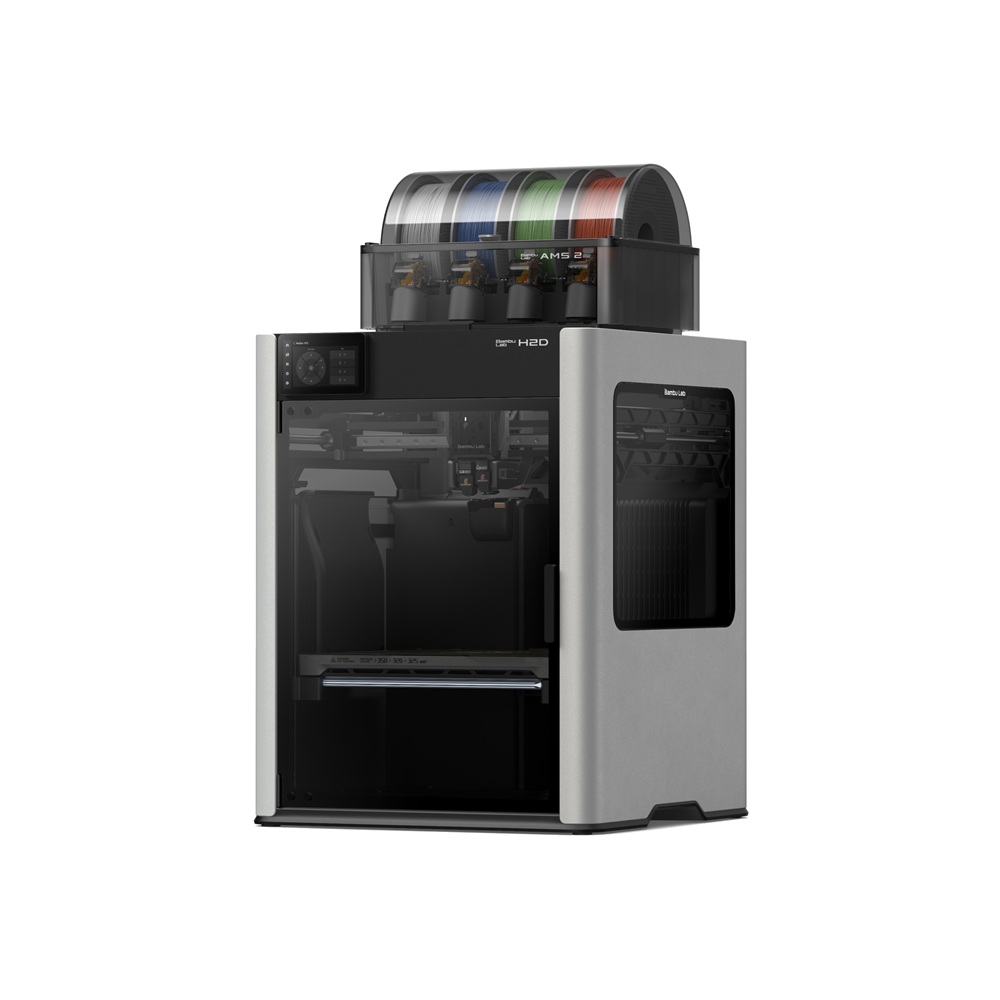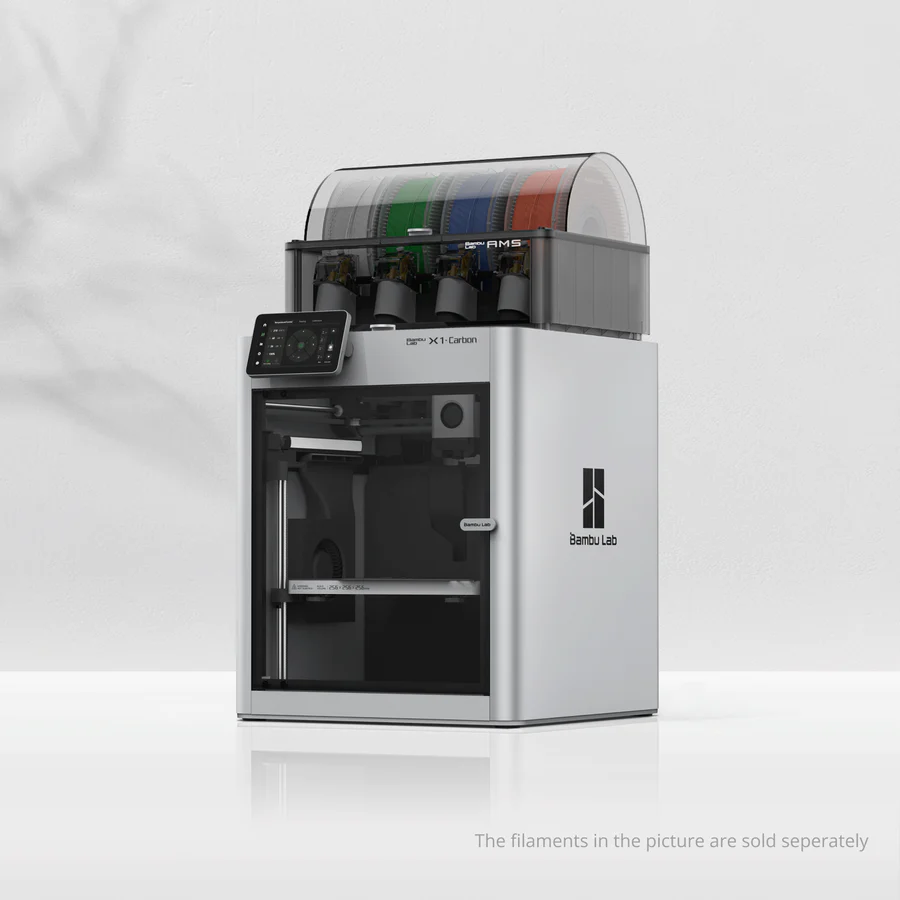Compare H2D vs X1 carbon
Comparison between the best 3D printers
Choose the best 3D printer at the best price. The cheapest 3D printers are here.
Buy a 3D printer here with 3D Fila.
 |
 |
|
| Model | H2D |
X1 carbon |
| Printing Material | Filament | Filament |
| Buy Filament for Bambu Lab H2D | Buy Filament forBambu Lab X1 carbon | |
| Estimated price | $1899,00 | $1449,00 |
| Manufacturer | Bambu Lab | Bambu Lab |
| Release Year | 2025 | 2023 |
| Print Volume [mm] | 350x320x325 | 256x256x256 |
| Printer Size [mm] | 492x514x626 | 389x389x457 |
| Weight [kg] | 42,3 | 14,13 |
| Power Loss Recovery | YES | YES |
| Enclosed printer | YES | YES |
| Bed Leveling | Automatic | Automatic |
| Filament End Sensor | YES | YES |
| Bed type | Heated | Heated |
| Power supply system | Direct Drive | Direct Drive |
| Standard nozzle | 0,4 | 0,4 |
| Maximum Nozzle Temperature [°C] | 350 | 300 |
| Maximum Bed Temperature [°C] | 120 | 120 |
| Maximum printing speed [mm/s] | 600 | 500 |
| Filament holder | YES | YES |
| Camera for supervision | YES | YES |
| Recommended filaments | PLA, PETG, ABS, ASA, TPU, PVA, Nylon (PA) | PLA, PETG, TPU, PVA, PA, PA-CF, Nylon, PC |
| Recommended slicers | Bambu Studio | Bambu Studio, Super Slicer, Cura, Prusa Slicer, Orca |
| Maximum Resolution [mm] | 0,01 | 0,1 |
| Processor | Quad ARM A7 1.2 GHz | |
| Display | Touchscreen 5'' | Touchscreen 5'' |
| Power Supply | 350 W | |
| Connectivity | Wifi, Bambu bus, Cartão SD | Wifi, Bambu bus, Cartão SD |
| Operating systems | Windows, Mac, Linux | Windows, Linux, Macbook |
| Date of registration in the system | 2025-03-31 | 2024-04-10 |
| Release date | 2025 | 2023 |
| Extra features | Bambu Labs H2D combines high-speed 3D printing with a chamber heated up to 65 °C, dual extrusion with automatic nozzle switching, an AMS for filament drying and exchange, and AI sensors that detect failures. It offers optional laser and digital cutting capabilities, features intelligent calibration through computer vision, vibration control, enhanced fire safety, and real-time camera monitoring. | The Bambu Lab X1 Carbon revolutionizes 3D printing with stunning design, high print speeds, and a streamlined user experience. It stands out with its CoreXY system, a hotend capable of reaching 300°C, allowing for a wide range of filaments. Its LiDAR-assisted bed leveling system, vibration compensation, and AMS multicolor printing capability raise the industry standard. Print quality is impressive, with the ability to fine-tune for perfection. The X1 Carbon, with its closed build volume, not only promises but also delivers one of the most advanced 3D printing experiences available to consumers. |
| Support for multiple colors and materials (AMS and CFS) | YES | YES |
Notes * |
||
| Cost-benefit | 7 / 10 | 7 / 10 |
| Hardware | 8 / 10 | 6.4 / 10 |
| Tela | . | . |
| Print volume | 4 / 10 | 4 / 10 |
| Performance | 5 / 10 | 4 / 10 |
Conclusion |
| In comparing the Bambu Lab H2D and the X1 Carbon 3D printers, several factors must be considered. Both models are manufactured by Bambu Lab and share similar features, such as automatic bed leveling, enclosed printing chambers, and support for a variety of filaments. However, the H2D offers superior print volume and higher maximum printing speeds, making it more suited for larger projects and faster production. The H2D is positioned as a more advanced machine, featuring cutting-edge technologies like dual extrusion with automatic nozzle switching and AI sensors for failure detection. This level of sophistication makes it ideal for professional users who require high precision and reliability. Furthermore, the H2D's release in 2025 suggests it might incorporate more recent advancements in 3D printing technology. On the other hand, the X1 Carbon, released in 2023, is no slouch either. It still boasts impressive features like LiDAR-assisted bed leveling and vibration compensation. While it supports slightly fewer print materials, it offers a robust experience for general-purpose 3D printing. Price is a factor as well; the X1 Carbon is notably less expensive than the H2D, which makes it an appealing choice for hobbyists or those entering the 3D printing space. However, with the high investment in the H2D, users may find value in its enhanced capabilities and larger print volume. In summary, the choice between the Bambu Lab H2D and the X1 Carbon hinges on the user's specific needs and budget. If larger print sizes and advanced features are priorities, the H2D is the clear winner. Conversely, for users who want excellent performance at a more accessible price point, the X1 Carbon represents a solid option. Both printers exhibit strong cost-benefit ratios, yet their target audiences may differ based on the intended use and investment readiness. |

